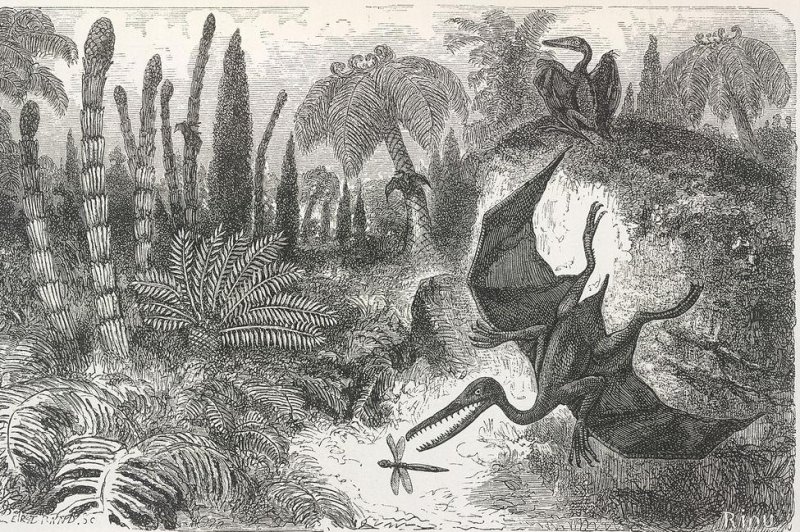"Landscape of the Liasic period," an illustration depicting a pterodactyl py French artist Édouard Riou. (CC/British Library)
WASHINGTON, April 24 (UPI) -- Pterodactyls, the now extinct genus of flying reptiles -- and part of the slightly larger pterodactyloids family -- is five million years older than previously thought. That according to a new study which details the 2001 discovery of the oldest pterodactyl species found to date.
Scientists estimate that the species Kryptodrakon progenitor spread its 4.5-foot wingspan roughly 163 million years ago. The found specimen's delicate bones were pulled from sand more than a decade ago during a dig at the Shishiugou Formation -- a treasure trove of Late Jurassic fossils located in a remote desert of northwest China.
Kryptodrakon, which translates to "hidden dragon," is an homage to the movie "Crouching Tiger, Hidden Dragon," which was filmed at a location nearby.
The bones of the ancient bird were originally misidentified, and weren't fingered as evidence of a new species of pterodactyls until scientists began reassembling the skeleton several years later.
"I looked at it and said, 'That's not a theropod, that's a pterosaur.' And the rest is history," James Clark, a biologist at George Washington University's Columbian College of Arts and Sciences, told National Geographic. Clark is co-author of a new paper on the rediscovery, which was published this week in the journal Current Biology.
The newly discovered species falls within the larger pterodactyloids family, a group that evolved from the even broader and more ancient order of pterosaurs -- the earliest flying vertebrates at 228 million years old.
The mystery of Kryptodrakon (now solved) moves the evolutionary split of pterodactyloids from pterosaurs back five million years, and offers scientists new insight into how the animals made the transition from a mostly marine existence to a predominantly terrestrial one.
"The pterodactyloid is the earliest, oldest and most primitive member of a group that would become huge," Brian Andres, lead author of the study and paleontologist at the University of South Florida, told PBS. "It would take over the skies. It would become the largest flying organism of all time."
"In paleontology, we love to find the earliest members of any group because we can look at them and figure out what they had that made the group so successful," Andres added.
[PBS News Hour]
[National Geographic]















